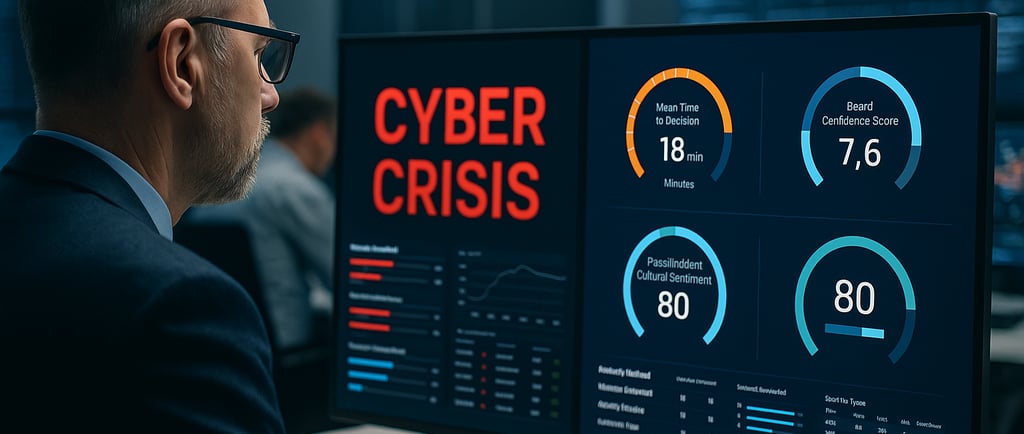Leading Through Cyber Crisis: Command Center Metrics That Inspire Confidence
When a cyber crisis strikes, the true measure of a CISO isn’t just how fast they contain the threat—it’s how effectively they lead. Stakeholders don’t merely need incident response; they need clarity, confidence, and credible metrics to trust that recovery is not only possible but already underway. In the heat of a breach, well-chosen command center metrics can bridge the gap between chaos and control.


Leading Through Cyber Crisis: Command Center Metrics That Inspire Confidence
When a cyber crisis strikes, the true measure of a CISO isn’t just how fast they contain the threat—it’s how effectively they lead. Stakeholders don’t merely need incident response; they need clarity, confidence, and credible metrics to trust that recovery is not only possible but already underway. In the heat of a breach, well-chosen command center metrics can bridge the gap between chaos and control.
Why Metrics Matter in a Crisis
In the throes of a security incident, it’s tempting to focus entirely on technical containment. But for executives, board members, regulators, and customers, what matters most is visibility: what’s happening, what’s being done, and how it impacts business outcomes. That’s where command center metrics come in. They translate the technical into the tangible.
Metrics during a crisis serve three essential functions:
Inform decision-making with facts, not fear.
Reassure stakeholders through transparency.
Enable coordinated response across business, legal, PR, and operations.
A command center isn’t just about firewalls and logs. It’s about communication, trust, and real-time leadership.
The Five Crisis Metrics Every CISO Should Track
1. Mean Time to Decision (MTTD)
This isn’t your standard MTTR (Mean Time to Recovery). MTTD measures how quickly your organization makes critical decisions after key discoveries. How fast did you decide to isolate a business unit? When did you trigger incident disclosure procedures? MTTD showcases decisiveness and cross-functional coordination—a hallmark of strong leadership.
2. Containment Confidence Score
This subjective but structured metric reflects how confident the incident team is in the effectiveness of current containment actions. It’s typically derived from internal consensus among technical leads, red team analysts, and forensic partners. Tracking this daily or hourly helps you communicate risk posture to execs.
3. Business Impact Index
This is a composite metric that aggregates downtime, revenue impact, customer disruption, and operational degradation into a single index. It should be updated in near real-time to provide a single view of business health. If your crisis response efforts are working, this index should gradually trend toward baseline.
4. Board Confidence Rating
After each major incident update, capture a quick pulse check from board or senior leadership. A 1-5 scale of perceived organizational control or confidence gives insight into how well your communication and response strategies are landing. It also signals when to adjust messaging.
5. Post-Incident Cultural Sentiment
After containment, use anonymous surveys or focus groups to assess how employees feel about leadership, transparency, and support during the crisis. Did they trust the process? Were they informed? This metric helps inform future tabletop exercises and cultural investments.
Case Example: Leading Through a Targeted Ransomware Attack
Imagine your organization has just been hit by a sophisticated ransomware attack targeting your finance systems. Within hours, you convene a cross-functional command center. You deploy forensic teams, notify your cyber insurer, and isolate impacted endpoints.
But the most critical asset isn’t your containment script—it’s your command center dashboard.
You display a real-time Business Impact Index showing which systems are down and the projected revenue hit. Your CISO provides hourly updates, including the latest Containment Confidence Score, showing gradual improvement. Meanwhile, your Board Confidence Rating remains stable at 4.2 out of 5, thanks to consistent messaging and clear action plans.
As containment succeeds, you roll out the first employee sentiment survey—and learn that while 78% felt informed, only 43% felt confident in the initial hours of the breach. That insight shapes your next crisis playbook.
Building the Metrics Infrastructure Before Crisis Hits
You can’t invent these metrics mid-crisis. Establishing a metric-driven command center starts with:
Predefining metrics and thresholds during tabletop exercises.
Configuring dashboards that ingest both technical and business data.
Training cross-functional teams to interpret and act on metrics.
A strong metrics culture ensures that when chaos strikes, you’re not relying on gut feel—you’re guiding the enterprise with data-backed confidence.
Final Thought: Metrics Build Trust, Not Just Reports
In a world where cyber attacks are inevitable, the differentiator isn’t immunity—it’s leadership. Metrics like MTTD and Board Confidence aren’t just nice-to-haves; they’re trust enablers. They let stakeholders know that even amid uncertainty, the CISO has a steady hand on the wheel.
If you want to explore how your organization can build a resilient, metrics-led incident response framework, reach out via tysonmartin.com. Let’s build trust through clarity, even in crisis.
